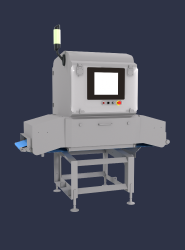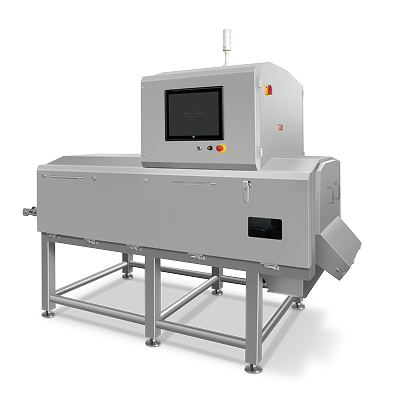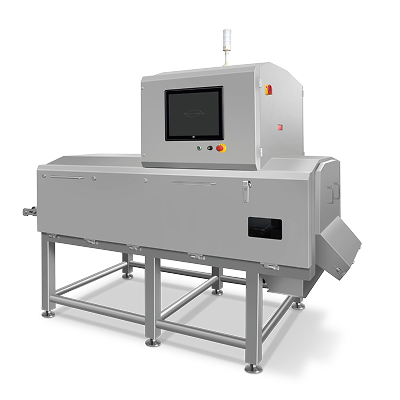RaymanTech Standard Dual Energy X-ray: Seeing the Invisible in Overlapped and Uneven Products
Picture a high-speed frozen broccoli line running at 60 meters per minute. Thousands of dark-green florets tumble straight from the IQF tunnel onto the belt. They overlap, fold, twist, and pile two or three deep. Some are still lightly coated with ice, others are perfectly dry. Hidden somewhere in that moving green avalanche is a sliver of blue plastic film, a tiny piece of rubber gasket, or a fragment of thin glass—contaminants that optical sorters will never see and metal detectors will never feel. A conventional single-energy X-ray machine struggles here too: the overlapping florets create dense, averaged shadows that swallow low-density foreign bodies whole. The contaminant simply disappears.
This exact scenario—dense, irregular, overlapping product that refuses to lie flat—is where RaymanTech’s Standard Dual Energy X-ray was born to dominate.
By simultaneously projecting high-energy and low-energy X-ray beams and mathematically comparing how each material absorbs them, the system determines the effective atomic number (Zeff) of every object in the image. Organic product, plastic, rubber, bone, and glass all reveal their true identity—no guessing, no averaging, no blind spots. Powerful AI then interprets those material maps in real time, flagging only what truly doesn’t belong.
The Standard Dual Energy modelis the most versatile member of this family, purpose-built for products that refuse to behave: frozen fries tumbling in flow packs, pumped chicken portions, shredded cheese, salad mixes, marinated seafood, bulk berries, or any application where items overlap, clump, or vary dramatically in thickness.
It catches what others miss:
· Thin low-density contaminants (plastic film, rubber, PVC, insects)
· Dense organics hidden inside product (bone fragments, wood, shell)
· Subtle defects (cracks, voids, missing pieces)
Detection sensitivity routinely reaches low-density foreign bodies, even when product piles three or four deep. Inspection widths range from 240 mm to 600 mm, heights up to 300 mm, and line speeds 10–60 m/min without compromise. The same hygienic advantages that define RaymanTech—IP67/IP69K stainless construction, 5-minute full washdown, ultra-low radiation leakage (<1 µSv/h)—are all present.
Hygiene and Durability Without Compromise
Food plants are hostile environments. The Standard model is built entirely from 304 stainless steel with continuously welded seams and fully sloped surfaces that shed water instantly. Up to the IP69K rating can withstand harsh environment in food manufacturing factories. The open-frame design leaves no horizontal surfaces for bacteria to hide.
Software That Thinks Like an Expert
The user interface is deliberately simple—large touch panel, intuitive icons, and one-button product changeover—but beneath it lies extraordinary intelligence. The AI continuously builds a statistical model of your specific product: size distribution, density variation, typical overlap patterns, seasonal moisture changes. It knows your product better than any human inspector ever could. When a new harvest delivers slightly denser or lighter florets, the system adapts automatically without operator intervention.
Applications Across the Plant
While the frozen-broccoli example perfectly illustrates the challenge, the Standard Dual Energy model is the go-to choice whenever product geometry is unpredictable:
· All IQF vegetables and fruits (broccoli, cauliflower, peas, corn, mixed cuts, berries)
· Pumped or marinated poultry portions
· Shredded, diced, or sliced cheese
· Fresh or frozen seafood (especially shrimp and surimi)
· Bulk nuts after shelling
· Ready-meal components before tray sealing
· Dry ingredients (spices, seeds, dehydrated vegetables)
For any line where overlapping, uneven, or highly variable product has made reliable inspection feel impossible, the Standard Dual Energy system finally delivers certainty. In short, if your product refuses to lie flat and single-energy X-ray has let you down, this is the machine that finally delivers certainty.


Related Articles
-
 Nov-19-2025
Nov-19-2025RaymanTech Dual Energy Residual Bone Detector: Absolute Bone Removal in Poultry Processing
Bone fragments are the poultry industry’s most persistent and expensive headache. Even the most advanced mechanical deboning systems leave behind collar bones, rib tips, fan bones, cartilage shards, and calcified tendon ends. These remnants are rarely metallic, often flexible, and almost impossible to see with the naked eye once the fillet is marinated, breaded, or frozen. Yet consumers notice them immediately—and one viral complaint can cost millions in lost contracts and brand damage.learn more -
 Nov-19-2025
Nov-19-2025Revolutionizing Needle Detection in the Meat Industry: Overcoming Hidden Risks with AI-Powered X-Ray Technology
As global demand for premium, safe meat products surges, processors are turning to advanced technologies to safeguard their supply chains. At RaymanTech, our AI-enhanced X-ray inspection systems are at the forefront of this transformation, offering unparalleled precision in detecting metal foreign objects like needle fragments. This article delves into the persistent pain points of needle detection in pork, beef, and lamb processing, the limitations of conventional tools, and how our innovative solutions deliver superior performance, drawing on the latest industry insights from RaymanTech's meat sector expertise.learn more -
 Nov-19-2025
Nov-19-2025RaymanTech's AI-Powered Multi-Channel X-Ray Solutions for High-Speed Food Safety
In the fast-paced world of food production, ensuring safety, quality, and efficiency is paramount. RaymanTech specializes in AI-driven technologies that address critical challenges in the food, pharmaceutical, and industrial sectors. RaymanTech AI X-ray Inspection System , along with metal detection, checkweighing, and optical sorting , empowers manufacturers to elevate food safety standards while optimizing operational efficiency. At RaymanTech, we understand that modern food production lines demand high-speed, high-volume processing without compromising on precision. This is where our expertise in multi-row, multi-column, and multi-channel X-ray detection shines, transforming industry pain points into opportunities for innovation and growth.learn more

Quick Links
Contact
Tel: 717-490-1513
Add: 1050 Kreider Drive -
Suite 500, Middletown,
PA 17057







